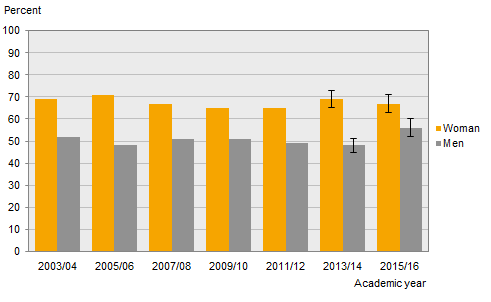Higher education plans of upper secondary school students. Academic year 2015/16:
Interest for higher education greater among women
Statistical news from Statistics Sweden 2016-03-08 9.30
Six out of ten upper secondary students graduating in the 2015/16 academic year plan to start university studies within three years. The percentage among women is about 65 percent compared to 55 percent among men.
The interest for higher education has been approximately the same since academic year 2003/04. The percentage of men with plans to start university studies increased between 2013/14 academic year and 2015/16. This means that the difference between men and women appears to have declined slightly.
Third year upper secondary school students, academic years 2003/04–2015/16. Broken down by sex and academic year

Of those who study a higher education preparatory programme, about 80 percent of the students have plans to study further. The interest for higher education is greatest among students who study the Natural Science Programme, at about 90 percent.
Of those who study a vocational programme, about 30 percent have plans to study further and about 50 percent have no such plans. Among women about 35 percent have no plans to start university studies compared to 55 percent among men.
The most common reasons why students want to study further are because it is required for the occupation they are aiming for, it means they can get an interesting job, it makes them more attractive in the labour market and that they want a job with a high salary. A higher proportion of women than men consider the main reason to be that it is required for the occupation they are aiming for. A higher proportion of men than women consider the main reason to be that they want a job with a high salary.
The distance to home is more important for women
As has been the case in the past ten years' surveys, the universities at Lund and Gothenburg are the most popular universities among the upper secondary school graduates. Stockholm University and Uppsala University are also popular.
The main reasons that students choose a particular school are the quality of education and that the school has a good reputation. Another reason is that it is close to home. The distance to home is more important for women than it is for men. Among women about 20 percent consider the main reason for choosing a particular school to be that it is close to home compared to 10 percent among men.
Women choose social sciences and men engineering
Social sciences and health care are popular educational orientations among women. Men prefer technology, economy and computing. About 15 percent of women wish to study social sciences compared to 5 percent of men. About 20 percent of men and 5 percent of women wish to study engineering. A higher proportion of women than men would also like to study a teacher education.
Women are more unsure of their choice of educational orientation than men. About 15 percent of the women are not at all sure of their choice of subject compared to only 5 percent of the men.
Those who do not want to study within three years want to work instead
About 15 percent of the women and 30 percent of the men have no plans to start university studies within the next three years. The most common reasons that students do not want to start a higher education are because they would rather work and/or are tired of studying. A higher proportion of women than men answers that that one reason is that they plan to study a different kind of education instead, such as adult education, or that they do not yet know what to do with their lives.
About 35 percent of those who study a higher education preparatory programme wish to study at a university/institute of higher education later, but not within the next three years. This can be compared to one in ten of those who study a vocational programme. For almost one in five of those enrolled in a vocational programme, one reason that they do not plan to study further is that they are not qualified to enter higher education studies. Approximately one in ten report that they have not been offered the courses required for eligibility to higher education.
Definitions and explanations
Higher education plans of upper secondary school students is a sample survey that has been conducted since the 1992/93 academic year. Until the 2003/04 academic year the survey was conducted every year. Since then it has been conducted every other year. The survey concerning 2015/16 academic year was conducted between October and December 2013. Information was collected via postal surveys and Internet surveys.
The target population is upper secondary students graduating in the 2015/16 academic year. The sample size was 4 996 individuals. The response rate, with regard to sample design, was 46 percent.
Publication
A more detailed report of this survey is published in the theme report Education 2016:2 Higher education plans of upper secondary school students.
Feel free to use the facts from this statistical news but remember to state Source: Statistics Sweden.
